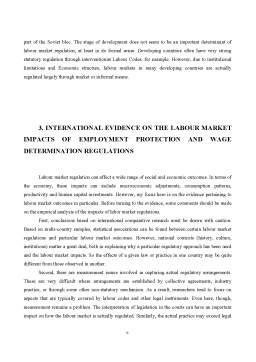Cuprins
- 1. Introduction
- 2. Modes of Labour Market Regulation
- 3. International evidence on the Labour Market impacts of employment protection and wage determination regulations
- 1. Employment protection
- - Dismissals
- - Hiring and contracting
- 2. Wage determination
- - Minimum wages
- - Collective bargaining
- 4. Enforcement and Dispute Resolution
- - Enforcement
- - Dispute Resolution
- 5. Conclusions
Extras din proiect
Labour market regulation (or the regulation of the labour market) involves many aspects, ranging from how employers contract for the services of labour to the nature of the exchange, including the rights and responsibilities of the parties, the terms and conditions of work and the resolution of disputes.
More than any other series of exchanges involving capital, the functioning of the labour market has a direct impact on the welfare of workers and their families. For this reason, combined with the scope of cultural, institutional, legal and political aspects involved, this area of regulation represents an important, visible and often controversial aspect of public policy in both developed and developing countries.
Approaches are dominated by opposing views, one which favors the protection of workers through labour legislation and collective bargaining and the other which emphasizes the advantages of encouraging market processes. In the end, however, what matters are the economic and social outcomes of different approaches.
1. INTRODUCTION
In its simplest form, the labour market – like all markets – is a repeated series of exchanges: in this case between capital and labour. For well-known reasons, though, labour markets – again like all markets – function in a much more complicated manner. They are affected by a mass of cultural, institutional, legal and political mechanisms. Together these mechanisms constitute what we mean by “labour market regulation.” There are many aspects involved, ranging from how employers contract for the services of labour to the nature of the exchange – including the rights and responsibilities of the parties, the terms and conditions of work and the resolution of disputes. Given the direct impacts that labour markets have on the welfare of workers and their families, this area of regulation represents an important, visible and often controversial aspect of public policy.
There are various reasons why societies may choose to intervene in the regulation of labour markets. These generally fall under two categories: market failures and injustice/exploitation. Thus, intervention may be motivated by either efficiency or equity reasons, or both.
Societies tend to respond to these concerns both informally and formally. Informal mechanisms often take the form of longstanding cultural practices – for example, traditional values of respect and justice that control exploitative behavior. However, the effectiveness of informal mechanisms is limited. As societies develop economically and social and community links often weaken, labour market regulation inevitably becomes more formal.
The two most prevalent formal modes are collective voice (through representation of the parties and voluntary collective bargaining) and direct government intervention through statutory regulation (e.g., labour laws, decrees, etc.). In all societies, these two modes of regulation will co-exist with market and informal mechanisms. But different societies clearly exhibit different mixes - for example, many observers have contrasted the market-oriented American approach with greater emphasis on statutory and collective voice regulation in many European countries. Regardless of the particular mix, however, public policy underpins the choice and provides the legitimacy for ongoing practices. This is most obvious in the case of statutory regulation. However, even where the “rules of the game” are determined by collective bargaining or market processes, public policy establishes the enabling framework.
Approaches to labour market regulation are dominated by two opposing perspectives – what Freeman has called the “institutionalist” and “distortionist” views. The “institutionalist” view sees job security arrangements, minimum wages, and collective bargaining as providing important social protection for workers, as instruments for encouraging productivity growth (through training and the accumulation of firm-specific skills), and as means of moderating the effects of downswings in aggregate demand. The “distortionist” perspective emphasizes the advantage of market processes and is concerned that these institutional forms of regulation impede adjustments to economic shocks, discourage hiring and favor “insiders” (i.e., regular workers).
In the end, however, what is critical are the economic and social outcomes of different approaches to regulation. How the labour market is regulated (in reality rather than simply “on paper”) can affect the rate of job creation and destruction; levels of employment and unemployment; productivity, wages and profits; and the degree of social protection and justice afforded workers. The key issue for policy- makers, then, is to try to understand the likely outcomes of different regulatory approaches. This is a difficult challenge which does not easily lend itself to conclusive empirical analysis. Nonetheless, different modes of regulation do have strengths and weaknesses and some conclusions can be drawn about the impacts of various approaches.
Preview document
Conținut arhivă zip
- Labour Market Regulation
- cuprins.doc
- labour market regulation.doc





















